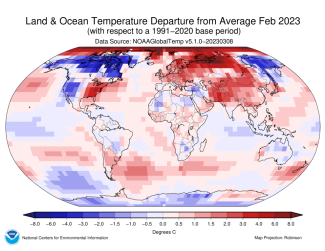Earth had its fourth-warmest February; Global sea ice extent hit record low for second consecutive month

February and Seasonal Highlights:
- The December–February period tied with 2018 and 2022 to rank fifth warmest on record.
- Europe had its second-warmest winter while Africa experienced its fourth-warmest December–February period.
- The Arctic saw its third-lowest sea ice extent for February; meanwhile, Antarctica hit a record low extent for the month and a record low for minimum seasonal extent.
- Tropical Cyclone Freddy, which tracked across the entire South Indian Ocean from Indonesia to the southeastern coast of Africa, has become one of the longest-lived tropical systems on record.
Globally, February 2023 was the fourth-warmest February in the 174-year NOAA record. The year-to-date (January-February) global surface temperature tied 2022 for the fourth warmest such period on record. According to NCEI’s Global Annual Temperature Outlook, it is virtually certain (> 99.0%) that the year 2023 will rank among the 10-warmest years on record and a 65% chance it will rank among the top five.
This monthly summary, developed by scientists at NOAA’s National Centers for Environmental Information, is part of the suite of climate services NOAA provides to government, business, academia and the public to support informed decision-making.
Coinciding with the release of the January 2023 Global Climate Report, the NOAA Global Surface Temperature (NOAAGlobalTemp) dataset version 5.1.0 replaced version 5.0.0. This new version includes complete global coverage and an extension of the data record back in time an additional 30 years to January 1850. While anomalies and ranks might differ slightly from what was reported previously, the main conclusions regarding global climate change are very similar to the previous version. Please see our Commonly Asked Questions Document and web story for additional information.
Monthly Global Temperature
The February global surface temperature was 1.75°F (0.97°C) above the 20th-century average of 53.9°F (12.1°C). Last month ranks as the fourth-warmest February in the 174-year record. February 2023 marked the 44th consecutive February and the 528th consecutive month with temperatures at least nominally above the 20th-century average.
Asia had its seventh-warmest February on record. South America, Europe, and Africa each had a February that ranked among their 20 warmest on record. North America and Oceania both had a warmer-than-average February, but it did not rank among the top-20 warmest on record.
Temperatures were above average throughout most of Europe, South America, central and southern Africa, the Arctic, and western, central, and southern Asia. Parts of southeastern and central-eastern North America and northeastern and southern Oceania also experienced warmer-than-average temperatures this month. Sea surface temperatures were above average across much of the northern, western, and southwestern Pacific and the Atlantic. Record warm temperatures covered about 4% of the world’s surface this month.
Temperatures were near to cooler than average across parts of western and northern North America, northeastern Asia, and northern Australia. Sea surface temperatures were near to below average over parts of the central Indian Ocean and the southeastern, central, and eastern tropical Pacific. None of the world's surface had a record-cold February.
Sea Ice and Snow Cover
Globally, February 2023 set a record for lowest February sea ice extent on record.
Arctic sea ice extent in February averaged 5.47 million square miles, which was about 260,000 square miles below the 1991–2020 average. This marks the third-smallest February extent in the 45-year record. The February 2023 Antarctic sea ice extent ranked lowest on record at 740,000 square miles, or about 460,000 square miles below the 1991-2020 average. Antarctic sea ice set a record low—35,900 square miles below the previous minimum seasonal record set in February 2022—as it hit its minimum extent for the year.
According to data from NOAA and analysis by the Rutgers Global Snow Lab, the Northern Hemisphere snow cover extent during February was 70,000 square miles below the 1991–2020 average. This ranks as the 26th-smallest Northern Hemisphere snow cover extent on record. Extent was above average in North America and below average in Eurasia.
Global Precipitation
Above-average February precipitation was observed across parts of western Asia, central eastern Europe, the Upper Midwest and Ohio Valley in North America, and northeastern and southeastern Oceania. Floods and landslides in Indonesia, New Zealand, South America, and southeast Africa fit the La Niña pattern of rainfall anomalies. Meanwhile, drier-than-average conditions were present across much of western Europe, South and Southeast Asia, Japan, Australia, Mexico, and the southern and eastern United States.
Seasonal Global Temperature
The December 2022–February 2023 global surface temperature was 1.62°F (0.90°C) above the 20th-century average of 53.8°F (12.1°C). This ranks as the fifth-warmest December–February period, tied with 2018 and 2022, in the 174-year record. The past nine December–February periods have ranked among the 10 warmest such periods on record.
The December–February period is defined as the Northern Hemisphere's meteorological winter and the Southern Hemisphere's meteorological summer. The Northern Hemisphere winter 2023 temperature was the fifth warmest on record at 2.25°F (1.25°C) above average. The Southern Hemisphere summer temperature ranked 10th warmest on record, tied with 2003 and 2006, at 0.97°F (0.54°C) above average. The Arctic region had its sixth-warmest winter on record, while Antarctica had its 10th-coldest summer.
Europe had its second-warmest meteorological winter on record at 4.50°F (2.50°C) above average. It was the fourth-warmest December–February period on record for Africa, while North America, South America, and Asia each had a top-20 warmest such period on record. Oceania had a warmer-than-average summer, but it was the region’s coolest summer since 2012.
Global Tropical Cyclones
Five named storms occurred across the globe this month. Four of those reached tropical cyclone strength (≥74 mph), and one reached major tropical cyclone strength (≥111 mph). The number of tropical cyclones was above the 1991-2020 normal (3.5 for February). The global accumulated cyclone energy (ACE: an integrated metric of the strength, frequency, and duration of tropical storms) was nearly twice its normal value and the second highest on record since 1972. The exceptionally long-lived Tropical Cyclone Freddy in the South Indian Ocean was responsible for about 75% of the ACE in February.
For a more complete summary of climate conditions and events, see our February 2023 Global Climate Report.






